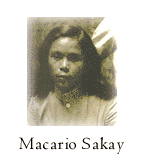Sakay
and his Resistance Movement
In
1902, the last of the Filipino generals, such as Miguel
Malvar and Simeon Ola
either surrendered or were captured. American annexation
had been completed and the civilian government of Taft
was established. As early as 1901, the Americans had
introduced a policy of attraction and accommodation
of the Filipino elite. True to their form, prominent
ilustrados, middle class Filipinos, welcomed
the opportunity. They pledged allegiance to the United
States and in return were rewarded with positions in
the colonial bureaucracy.
 But
pacification was still far from over. Throughout the
first decade of American rule, several patriotic Filipinos
continued the resistance. A shining example was General Macario Sakay who, in 1902, proclaimed
the Supreme Government of the Tagalog Archipelago with
himself as President and Commander-in-Chief. In his
manifesto, he declared a free Tagalog Archipelago which
included all the towns and provinces of Luzon, Visayas
and Mindanao. He claimed that his Tagalog Republic was
a continuation of Bonifacio’s Katipunan which started
the Philippine Revolution in 1896. In claiming ties
with the Katipunan, Sakay aligned the Tagalog Republic
with the Katipunan. Even his flag was a blazing sun
with letter K perhaps for Katipunan and/or Kalayaan.
He drew up a constitution and proclaimed several circulars
and manifestos extolling the Filipinos to continue the
campaign for independence started by Bonifacio and the
Katipunan. He warned the Filipinos not to swear allegiance
to the United States. But
pacification was still far from over. Throughout the
first decade of American rule, several patriotic Filipinos
continued the resistance. A shining example was General Macario Sakay who, in 1902, proclaimed
the Supreme Government of the Tagalog Archipelago with
himself as President and Commander-in-Chief. In his
manifesto, he declared a free Tagalog Archipelago which
included all the towns and provinces of Luzon, Visayas
and Mindanao. He claimed that his Tagalog Republic was
a continuation of Bonifacio’s Katipunan which started
the Philippine Revolution in 1896. In claiming ties
with the Katipunan, Sakay aligned the Tagalog Republic
with the Katipunan. Even his flag was a blazing sun
with letter K perhaps for Katipunan and/or Kalayaan.
He drew up a constitution and proclaimed several circulars
and manifestos extolling the Filipinos to continue the
campaign for independence started by Bonifacio and the
Katipunan. He warned the Filipinos not to swear allegiance
to the United States.
Meanwhile,
the Americans waged a propaganda campaign against Sakay
and his supporters. They branded Sakay as bandido
or a bandit who preyed on innocent Filipinos. Even Sakay’s
physical appearance was used to damage his character.
The Americans noted that Sakay sported long hair, a
proof that he was indeed a bandit. But Sakay purposely
did not cut his hair because its length was indicative
of the length of their struggle. American anti-Sakay
propaganda was so effective that the stereotype image
of bandits sporting long hair, like Sakay, was embedded
in the mentality of Filipinos even after the war.
Sakay
operated in the Southern Tagalog provinces of Rizal,
Laguna, Cavite, and Tayabas. His headquarters was first
in Mt. Cristobal, Tayabas, and later transferred in
the mountains of Morong, Rizal. In 1906 or four years
after he proclaimed the Tagalog Republic, he was persuaded
to lay down his arms for the sake of peace. His surrender
was necessary to establish a state of peace that was
a prerequisite for the election of Filipino delegates
to the American sponsored legislative body called Philippine
Assembly. Sakay viewed his surrender not as capitulation
but as a genuine step towards independence. He believed
that the struggle had shifted to constitutional methods
and that through the Philippine Assembly, the Filipinos
could win their independence. For ending his resistance,
Sakay and his forces were promised general amnesty.
On
July 4, 1906, Sakay went down to Manila from the hills
of Tanay, Rizal. An eyewitness claimed that Sakay and
his men were followed by a brass band and hundreds of
townspeople supporting him and shouting "Long Live
Sakay! Long Live the Patriots!" In recognition
of his heroism and patriotism, various Filipino banquets,
dances and celebrations were held in his honor. But
a trap was apparently being laid out for him by the
Americans. On July 17, 1906, he was arrested and imprisoned
on charges of banditry. Subjected to a court trial,
Sakay was found guilty and ordered hanged on August
6, 1907.
But
Sakay was not a bandit. In his proclamations, he recognized
the right to privacy and called on his followers to
respect the life, livelihood, and property of the people.
He also advocated respect of women and their honor.
By calling Sakay a bandit, the Americans disparaged
the righteousness of Sakay’s cause and relegated
him to a mere criminal. Sakay was a nationalist who
envisioned a free and independent Philippines, and he
continued the struggle for its attainment when most
of the ilustrado Filipino leaders had opted to
collaborate with the new colonizers to protect their
own personal interests.
Sakay’s
resistance was the last episode in the Philippine-American
War. Figures on the extent of the casualties of the
war vary, ranging from 600,000 to half a million Filipinos.
Its gravity, however, was captured by a U.S. Congressman
who stated at the turn of the century that "they
never rebel in Luzon anymore because there isn’t
anybody left to rebel." But the next forty-five
years of American benevolent colonialism and the succeeding
three brutal years of Japanese occupation, where the
Filipinos and the Americans fought side by side, have
seemingly dulled if not erased the bitter memories of
a costly and savage Philippine-American War. Fortunately,
the 1998 centennial celebration of the Philippine Independence
have highlighted the series of events a hundred years
ago which have become the defining moment of Filipino
nationalism.
|

